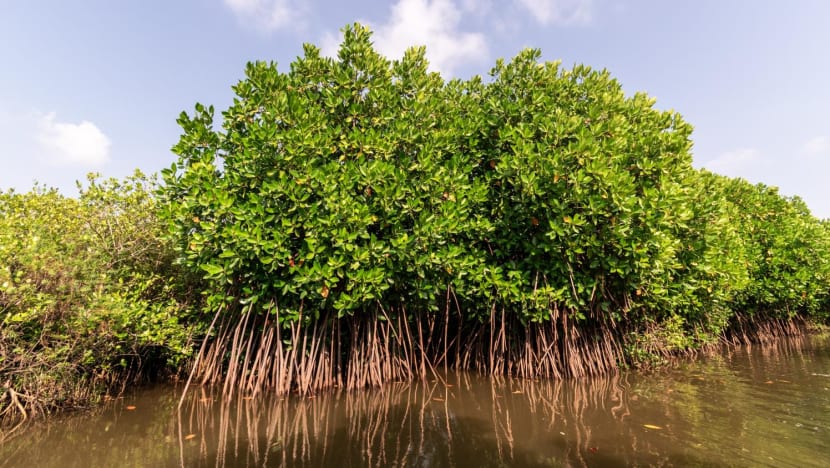Banking on mangrove restoration to boost carbon storage capabilities
The OCBC Mangrove Park in Pulau Ubin is the first large-scale project in Singapore to adopt a landmark restoration method for long-term mangrove habitat resilience.

Mangroves, with their powerful carbon-storage capabilities, can help in the fight against climate change. Photos, video: OCBC Bank
More than just a home for frogs, insects and fishes, mangrove habitats are highly valuable resources that play a significant role in battling climate change.
One of the top carbon-capturing ecosystems on Earth, mangrove forests are estimated to store up to three to four times more carbon than other types of tropical forests.
Unfortunately, mangroves are also among the most threatened habitats in the world, no thanks to deforestation, aquaculture and pollution. Over the last decades, around 1.04 million hectares of mangroves have been degraded or destroyed worldwide. Today, less than 5 per cent of Singapore’s original mangrove forests over the last two centuries remains.
As part of its commitment to sustainability and climate action, as well as its ongoing support for the Singapore Green Plan 2030, OCBC Bank has pledged more than S$3 million for mangrove restoration projects in Singapore and Malaysia. This is just one of its latest moves to expand its carbon storage efforts and help fight climate change.
STORING CARBON THE NATURAL WAY
Over the years, OCBC has been supporting strategic reforestation and restoration projects in the region to help store carbon.
In Singapore, the carbon-storing journey started in 2019 with the OCBC Arboretum, a forest of endangered trees that is able to absorb 80 million kilograms of carbon dioxide. The journey continues with OCBC’s 90th anniversary celebrations – OCBC will help to grow 9,000 mangrove trees at the OCBC Mangrove Park and along the coastlines at Pulau Ubin, as well as another 9,000 trees at the Tebuk Mendeleng mangrove project in Malaysia.

In Singapore, this project is underway. Partnering the National Parks Board (NParks), OCBC has launched the OCBC Mangrove Park restoration site, employing the landmark EMR (ecological mangrove restoration) method for sustainable, long-term mangrove propagation.
As a natural resource that can absorb significant amounts of carbon dioxide, trees are an important factor in OCBC’s climate-change efforts. From the conservation of threatened dipterocarp trees at the OCBC Arboretum to the OCBC habitat enhancement programme at Coney Island and this latest effort of mangrove restoration at the OCBC Mangrove Park and Tebuk Mendeleng, OCBC has supported reforestation and tree restoration work across the region that can absorb an estimated 111 million kilograms of carbon dioxide.
A RESTORATION MODEL FOR THE REGION
EMR is especially promising as a method of mangrove restoration because it allows nature to do the work of replanting and nurturing mangrove trees.
The EMR method considers species-specific traits and site characteristics, including elevation and the height of tides, and works with physical processes to improve restoration success by ensuring that the site conditions are right for the mangrove species selected. Instead of manually planting propagules and saplings, EMR allows for the natural propagation of mangrove seeds and propagules that are washed in by sea tides. The end result is a mangrove forest that grows faster and is better able to survive.
Once completed, minimal human intervention is required to sustain the mangrove habitat, compared to traditional approaches that focus on planting mangroves. Hence, the EMR method is more sustainable in the long term and can be scaled up easily for similar mangrove restoration efforts in the region.

The OCBC Mangrove Park is the first large-scale project in Singapore to adopt the EMR method. Spanning around four hectares, the restoration site is located at the Sungei Durian ponds at Pulau Ubin – an area once home to natural mangroves. Converted into aquaculture ponds in the 1990s, they were abandoned in 2001.
To carry out EMR, the OCBC Mangrove Park will have the elevation levels of its pond bases increased, so that seeds and propagules can establish themselves more easily. Drain culverts will improve water flow to increase natural sedimentation, which is beneficial for mangrove roots.
By 2026, around 8,000 mangrove trees are expected to take root at the OCBC Mangrove Park. OCBC staff volunteers and members of community groups like Friends of Ubin Network will plant an additional 1,000 mangrove saplings along the Pulau Ubin coastline in the next six years, to protect shorelines against erosion and storm surges. This contributes to NParks’ OneMillionTrees movement, which is Singapore’s national goal of planting one million more trees by 2030.
All 9,000 mangrove trees are expected to absorb up to 30 million kilograms of carbon dioxide in their lifetimes. Combined with the surrounding mudflats and soil, the amount of carbon stored could be three to four times more than the amount stored by trees on land.
A STEP TOWARDS TACKLING CLIMATE CHANGE

The OCBC Mangrove Park project was launched by Mr Desmond Lee, Minister for National Development; Ms Helen Wong, group CEO of OCBC Bank; Mr Kenneth Er, CEO of NParks; and Professor Leo Tan, chairman of the Garden City Fund.
Highlighting that the OCBC Mangrove Park will not only restore and safeguard Singapore’s mangroves but also complement ongoing nature-based solutions implemented by NParks, Mr Lee said: “These solutions are important in mitigating climate change and offer additional habitats for our native biodiversity.”
The OCBC Mangrove Park will also play an important role in community engagement. The park’s accessibility will be enhanced so that recreational and outreach programmes can be carried out following its opening in 2026.
“Studies have shown that removing carbon dioxide from the atmosphere through reforestation is a key strategy to curb climate change,” said Ms Wong. “We are glad that we can expand our carbon depository through reforestation and mangrove restoration efforts, first with the OCBC Arboretum in 2019 and now with the OCBC Mangrove Park. This project is a big step in our environmental journey and makes for a fitting 90th anniversary gift from us to Singapore, as we work with the community to tackle climate change.”
Learn more about the OCBC Mangrove Park.















